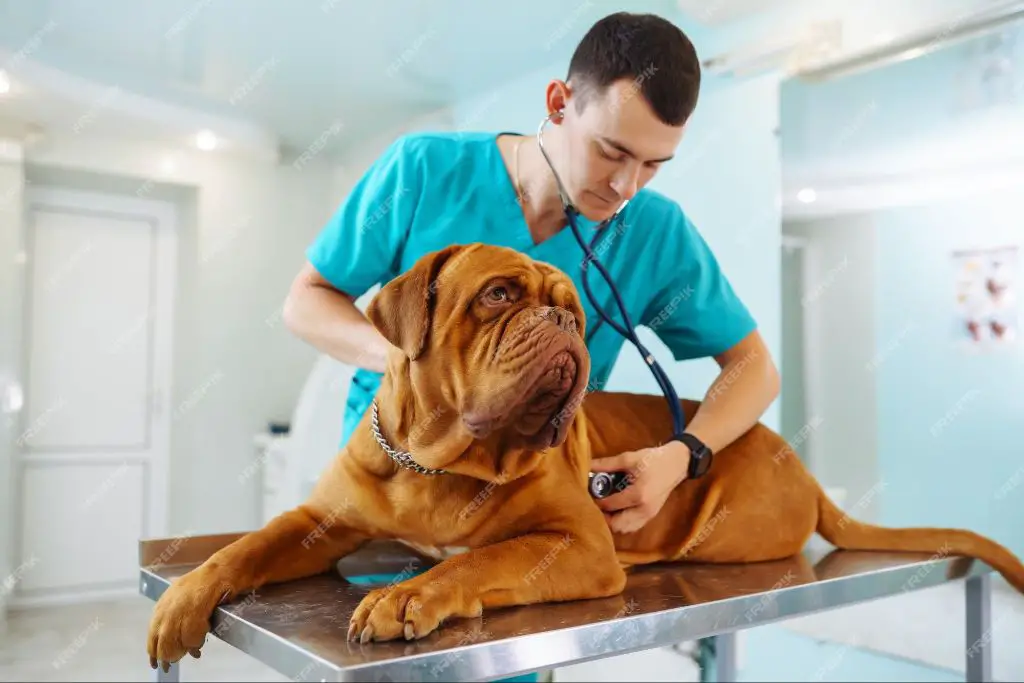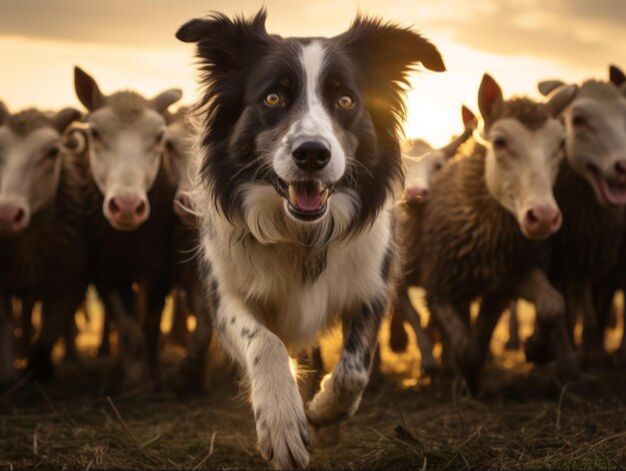Sudden Onset of Obsession
It can be alarming when your dog suddenly becomes obsessed with your other dog. This type of behavior tends to arise fairly quickly, going from no obsession to constant fixation within days or weeks. You may notice your dog following the other dog around constantly, staring intently, sniffing them obsessively, and wanting to be touching them or as close as possible at all times.
Some examples of obsessive behaviors include:
- Following the other dog from room to room
- Staring at the other dog for long periods
- Sniffing and licking the other dog excessively
- Sleeping right up against the other dog
- Becoming distressed when separated from the other dog
These types of clingy, fixated behaviors tend to come on strong and progress rapidly once they start. Understanding when the obsession began and how it manifests can help uncover the root causes behind it.
Possible Medical Causes
Dogs can experience sudden changes in behavior when suffering from medical conditions that affect the nervous system or cause pain or discomfort. Here are some common medical causes for obsessive behavior in dogs:
Cognitive dysfunction syndrome: Also known as canine dementia, this condition is similar to Alzheimer’s disease in humans. It leads to confusion, memory loss, personality changes, and repetitive behaviors like pacing and obsessive licking.
Brain tumors: Tumors in the brain can stimulate obsessive behaviors like tail chasing, fly biting, or staring at walls. Brain tumors may also cause seizures, imbalance, and other neurological symptoms.
Thyroid disease: An overactive or underactive thyroid gland can lead to aggression, anxiety, and obsessive behaviors like licking or chewing at certain spots.
Urinary tract infections: A UTI causes discomfort during urination. Some dogs start obsessively seeking water or develop repetitive water drinking if they have a chronic UTI.
Skin allergies: Dogs with itchy skin allergies may obsessively lick, chew or scratch at irritated spots on their bodies.
Pain: Discomfort from arthritis, injuries or other conditions can cause dogs to obsessively focus on the painful area, licking or chewing at it repeatedly.
If a physical health problem is suspected, a veterinarian should thoroughly examine the dog and run proper diagnostic tests. Treating the medical issue can often resolve obsessive behaviors related to it.

Resource Guarding
Resource guarding is a common cause of sudden obsession in dogs. This is when a dog shows possessive aggressive behavior over resources like food, toys, beds, or even owner attention. The obsessive dog may start guarding these resources from the other dog, often trying to control access to these items.
This usually stems from anxiety over potentially losing the resource. The dog feels the need to constantly monitor and control the resource. This can progress into obsession over things they never cared much about before.
To manage resource guarding between dogs:
- Feed dogs separately to avoid food aggression.
- Provide multiple copies of favorite toys and beds.
- Don’t give high-value treats or new toys when dogs are together.
- Separate dogs when giving affection or attention.
- Train “drop it” and “leave it” commands.
- Redirect obsessive behavior towards more positive activities.
With patience and proper management, resource guarding obsessions can be reduced over time.
Fear and Anxiety
Anxiety and fear are common causes of sudden obsessive behaviors in dogs. Separation anxiety, loud noises, strangers, or unfamiliar environments can trigger obsessive actions as a self-soothing mechanism. The dog may excessively lick itself or another animal, pace, bark, whine, or engage in repetitive motions to relieve their stress and anxiety.
Try to identify the source of your dog’s anxiety. If they act obsessive when left alone, separation anxiety is likely the culprit. Fear of strangers or noises points to general anxiety issues. Once the trigger is identified, there are ways to help calm your dog’s anxiety and obsessive habits.
Creating a safe space with familiar scents can provide comfort for an anxious dog. Providing puzzle toys when you leave can distract them from stress. Introducing new sights and sounds gradually can desensitize a noise or stranger-phobic dog. Confinement when guests arrive may help high-strung dogs feel secure. Anxiety wraps and pheromone collars can have calming effects.

Obsessive licking and other repetitive motions release endorphins that relieve stress for the dog. Redirecting these behaviors to more constructive outlets like a Kong or obedience training can satisfy their needs in a healthier way. Consulting a vet or dog trainer may be needed for severe anxiety. Medication and specialized training can help dogs overcome intense fears leading to obsessive behaviors.
Boredom
Lack of physical and mental stimulation can lead to obsessive staring, following, and pestering of other dogs. Without enough activity and enrichment, your dog may fixate on the other dog in the household simply out of boredom. Try engaging your dog’s natural instincts by providing more opportunities for:
- Exercise – Take long walks, go hiking, play fetch or frisbee, swim, etc. Vary the locations and increase duration and intensity.
- Play – Use interactive toys like Kongs, puzzle toys, treat balls. Play hide and seek with treats and toys.
- Training – Practice new commands, tricks, and behaviors. Work on challenges like agility or nosework.
- Foraging – Use snuffle mats, hide kibble around the house, provide chew toys and bones.
- Socialization – Arrange play dates with neighbor dogs at a park or doggy daycare.
- Mental Stimulation – Provide new sights, sounds, smells, textures to explore safely.
Making time for your dog’s needs daily will help prevent obsessive fixations and behavior problems.
Lack of Training
If your dog is obsessed with your other dog, it may be because you have not set clear boundaries for your dog’s behavior. Dogs thrive on structure and can become anxious or pushy when there are no rules. Without training, your dog may not understand that obsessively following the other dog is unacceptable.
Here are some tips for training your dog not to obsess over the other dog in your home:
- Teach your dog the “leave it” command. Reward your dog with treats when they disengage from the other dog on cue.
- Practice having your dogs in the same room on leashes. Calmly correct obsessivefocus and reward relaxed behavior.
- Crate train your dogs to give them forced breaks from each other. Ensure crates are positive spaces.
- Use baby gates to separate dogs when unsupervised. This prevents rehearsal of obsessive following.
- Provide plenty of exercise, training, and enrichment activities. A bored dog will often fixate.
- Consult a certified dog trainer if your dog’s obsession seems extreme. Professional support can help.
With patience and consistency, you can train your dog to show restraint and independence around your other dog. Setting rules and boundaries will help your whole pack.
Changes in Pack Dynamics
Dogs are pack animals and establish a social hierarchy amongst themselves. Sudden obsessive behavior between two dogs who previously coexisted peacefully may indicate a disruption in the pack dynamics. Some potential triggers for this include:
New Dog or Person in the Home: Bringing a new dog into the home can threaten the existing social order. The resident dog may become obsessive over the new dog in an attempt to establish dominance. Similarly, a new person in the home, like a new baby, spouse or roommate, can also shake up the pack structure from the dog’s perspective.
Dogs Reaching Maturity: As dogs grow out of puppyhood and into adulthood, their natural behaviors and tendencies emerge more strongly. Two dogs who got along as puppies may start vying for dominance as they reach social maturity between 1-3 years old.
Fights or Tension Between Dogs: Sometimes a fight or other negative interaction between dogs can instigate obsessive behaviors like guarding food, toys or people. The dogs may be trying to re-establish the pack structure through these behaviors.
To reduce tension and obsessive behavior related to pack dynamics, give each dog individual attention, obedience training and outlets for their energy. Reinforce that all resources and privileges come from you. Consult a trainer or behaviorist for help easing multi-dog households back into balance and harmony.
Breed Traits
Certain breeds like herding dogs (e.g. border collies, Australian shepherds), sporting dogs (e.g. Labradors, golden retrievers), and working dogs (e.g. Siberian huskies, malamutes) are more prone to fixating or obsessing over other animals due to their natural instincts. Herding breeds were bred to control the movement of livestock by stalking and circling them. Sporting dogs were bred to track and retrieve downed birds during a hunt. And sled dogs like huskies and malamutes love to pull and run in packs.

If your dog is from one of these working breeds, their obsessive behavior may simply be a manifestation of these innate genetic traits and drives. They become intensely focused on a new object, animal, or activity that captures their attention and interest. If your dog is fixating on your other dog, it may be trying to herd or control it by stalking and circling. Or your dog sees the other as new prey to be tracked or chased down. These instincts can be triggered by a new dog entering the home.
Rather than trying to eliminate these behaviors, a more realistic goal is to manage them. Increase physical and mental stimulation through more rigorous daily exercise, engaging training sessions, or food puzzle toys. Teach your dog commands like “leave it” and “settle” to snap them out of an obsessed state. And provide plenty of proper outlets for their energy such as agility, running, scent work etc. This fulfills their needs in a productive way.
When to Seek Help
If obsession persists despite efforts, professional help may be needed. Certified trainers, veterinary behaviorists, and your vet can provide an experienced perspective on your dog’s behavior. They can evaluate whether there is an underlying medical issue and provide training techniques tailored to your situation.
Signs that it may be time to seek outside help include:
- Obsession is excessive and worsening
- Your dog shows aggression or other dangerous behaviors
- You’ve tried training techniques without improvement
- The obsessive behavior is causing significant distress
- Other behavioral issues arise alongside the obsession
- Your dog’s quality of life seems impacted
An experienced professional can identify factors you may have missed and provide a customized training and treatment plan. They can also teach you how to better understand dog psychology and equip you with skills to handle this and future issues. Getting the right help benefits both you and your dog’s wellbeing.
Preventing Future Obsessions
To prevent obsessive behavior from developing in dogs, it’s important to properly socialize them and set clear boundaries from a young age. Here are some tips:

-
Expose puppies to new people, dogs, places, sights and sounds frequently starting at 7-12 weeks old. Let them approach calmly, reward and praise for positive interactions.
-
Provide obedience training using positive reinforcement starting early. This teaches impulse control, manners and respect.
-
Give your dog physical and mental exercise daily to prevent boredom. Take interactive walks, play games, use puzzle toys.
-
Set a routine with scheduled walks, playtime, training and downtime. Consistency provides security.
-
Reinforce calm, relaxed behaviors. Reward them for settling on their own.
-
Give each dog individual attention daily. Separate them sometimes to strengthen their bond with you.
-
Interrupt and redirect obsessive behaviors right away, like staring, nipping or barking. Redirect their focus to a toy or treat.
-
Consult a certified dog trainer or behaviorist if issues arise. Early intervention prevents worsening.
With proper socialization, training and boundaries from puppyhood, you can curb obsessive tendencies and raise a well-adjusted, relaxed dog.